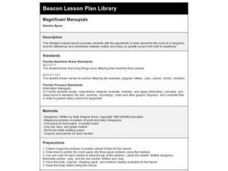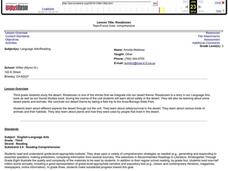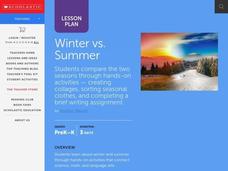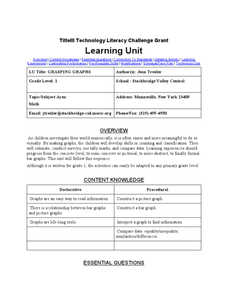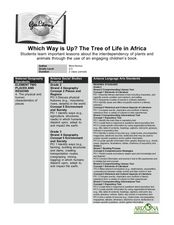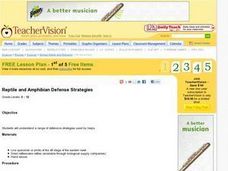Curated OER
Magnificent Marsupials
Students have the opportunity to explore the life cycle of a kangaroo, and the differences and similarities between mother and baby as growth occurs from birth to adulthood. They draw pictures of the mother and the joey and compare them.
Curated OER
Roxaboxen
Third graders discuss the story "Roxaboxen." In this reading comprehension lesson, 3rd graders discover new vocabulary words, discuss the story using story mapping, and take a reading test. Students investigate safety in the desert and...
Curated OER
Sand & Water: Shape Search
Learners act as amateur archaeologists as they participate in their own "dig" to explore and record unusual shapes. In this shape exploration lesson, students use trowels and shovels to dig, and learn to sift the dirt with screens to...
Curated OER
Fossil Evidence for Plate Tectonics
Learners draw maps of counties that were important to the discovery of plate tectonic theory. In this plate tectonics lesson plan students excavate constructed fossil sites from matching coastlines and discuss the possible...
Curated OER
Amazon Rainforest: You Won't Find George in This Jungle
Students identify locations of rainforests, compare/contrast layers of the rainforest, construct and interpret maps and graphs, recognize relationships between man and the environment, and write about an imaginary walk in the rainforest.
Curated OER
Food Web Follies
Seventh graders cut and paste animal pictures to create a food web and trace the path of energy. They write a paragraph explaining the importance of photosynthesis in all food webs.
Curated OER
Woodland Math Facts
In this Woodland math facts worksheet, students study and examine woodland weights of trees and shrubs, explore invertebrates and draw a bar chart to chart their findings.
Curated OER
Understanding Climate
Fourth graders create two dioramas out of household materials to compare the influence of various factors that impact climate. Each group discuss how the change in factors influenced the climate, flora, and fauna of their area.
Curated OER
Click, Clack, Moo: Electric Blanket Science
Young scholars read Click, Clack, Moo: Cows That Type by Doreen Cronin and discuss the similarities and differences between electric blankets and regular blankets. They brainstorm a list of reasons why the farm animals wanted electric...
Curated OER
Marshland Wonders
Learners review the characteristics of wetlands and list their benefits. After viewing short videos, they identify the organims that make their home in wetlands and how they have adapted. They compare and contrast the characteristics...
Curated OER
Standard Deviation
In this standard deviation worksheet, students solve and complete 10 different types of problems. First, they determine the number of standard deviations an item was from its mean. Then, students draw a model of what this would look...
Curated OER
Fun with Flowers
Students make observations of flowers. In this life science lesson, students look at flowers, then draw and color their favorite flowers. Lesson includes extension activities.
Curated OER
It Counts
Young scholars assign numbers to describe objects. In this number instructional activity, students assign numbers to objects and compare more, less, and equal values. They write down descriptions of plants including the number of leaves...
Curated OER
Winter vs. Summer
Students explore the seasons. For this winter and summer lesson, students read The Snowy Day by Ezra Jack Keats and Summer by Maria Ruis. Students compare the 2 seasons as they create t-charts, try on seasonal clothing, and create collages.
Curated OER
Plankton
Students research phytoplankton and zooplankton. In this food chain lesson plan, students read This is the Sea That Feeds Us and discuss plankton, food chains, and webs. Students define phytoplankton and compare them to land...
Curated OER
Technology Literacy Challenge Grant Learning Unit
First graders explore counting and classification. They sort leaves, create graphs, write sentences for the data in the graphs, develop graphs for shapes, favorite animals, birthdays, and participate in a die prediction game.
Curated OER
Science: Where the Worms Live
Students build mine-earthworm habitats to discover their niche in them. They make predictions about what the niche looks like in a week and draw a picture of it. Students notice the tunnels in the soil and how the sand and dirt are now...
Curated OER
Leapin' Lizards And Other Facts About Reptiles And Amphibians
Learners compare and contrast reptiles and amphibians. As a class, students discuss the yellow-spotted lizard mentioned in the novel Holes. Using internet resources, learners research facts about reptiles and amphibians and document...
Curated OER
Observing Specialized Cells
In this plant and animal cell worksheet, students draw five examples of plant or animal cells that are specialized to perform a particular functions. They also complete 6 short answer questions based on their observations.
Curated OER
The Roanoke Mystery
Fourth graders hypothesize about what happened on the island of Roanoke. In this South Carolina history lesson, 4th graders use primary documents to draw conclusions about what happened to the Lost Colony of Roanoke. This mini-unit...
Curated OER
Sea Turtle Rescue
Students create a three column chart about working with wildlife and how different organizations help sea turtles. In this sea turtles lesson plan, students compare the Oregon Coast Aquarium, the Coast Guard, and Sea World and what they...
Curated OER
Owen
Students read Owen by Kevin Henkes. In this literature lesson, students listen to the story and compare it to other Kevin Henkes books. They answer comprehension questions and bring their own treasured item to share.
Curated OER
Which Way is Up? The Tree of Life in Africa
Students read a book titled This is the Tree about a baobab tree and draw a picture and label the tree. In this tree lesson plan, students also write a paragraph explaining why they drew that tree.
Curated OER
Reptile and Amphibian Defense Strategies
Students study the stages of the Eastern newt either by collecting a live specimen or from pictures. They note the colors of the eft stage before reading the "Eastern Newt Species Account" that shows the newt's life stages, migration,...
